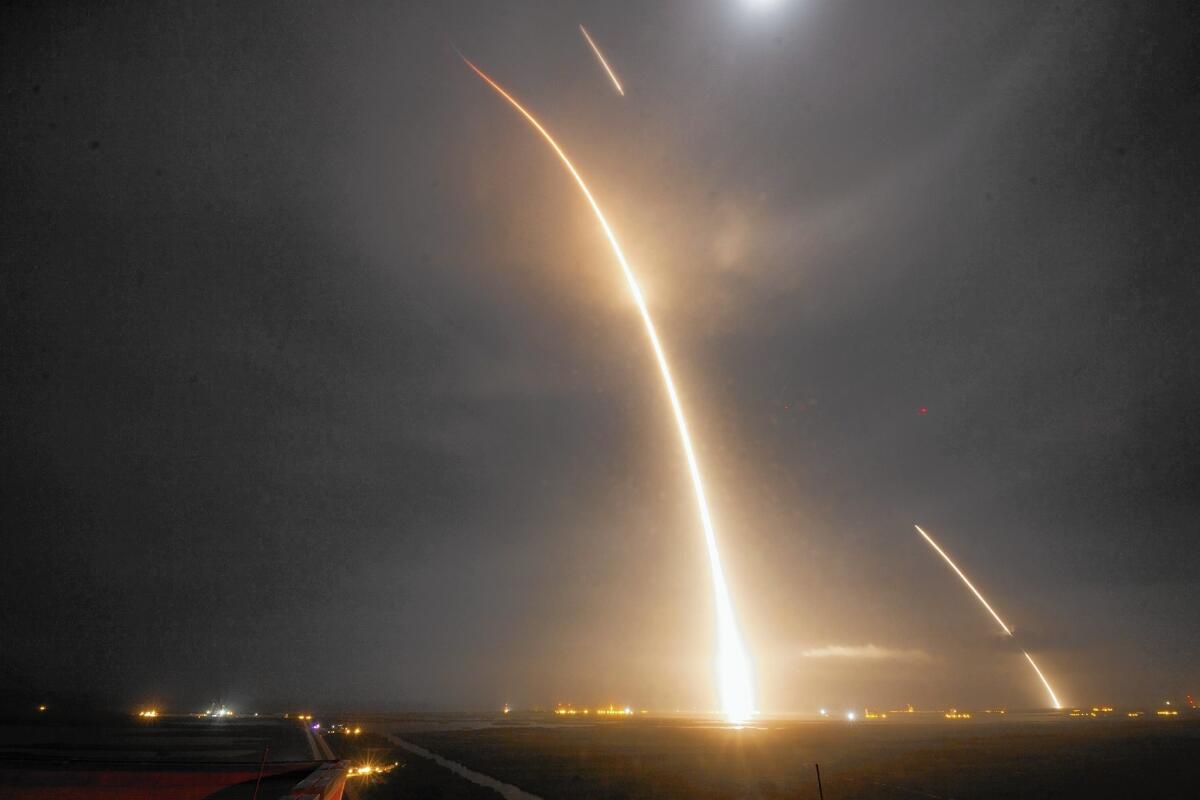SpaceX landing hailed as giant leap for space travel

- Share via
When Elon Musk’s SpaceX rocket nailed its historic landing at Florida’s Cape Canaveral on Monday night and the enormous dust cloud settled, it was more than an engineering feat hailed around the world.
The Falcon 9’s landing made deep space travel seem attainable again — not just to aerospace engineers and astronauts but to the masses.
------------
FOR THE RECORD:
SpaceX: In the Dec. 23 Section A, an article about the historic landing of the SpaceX Falcon 9 misspelled the name of Jeff Bezos’ Blue Origin space vehicle New Shepard as New Shepherd. —
------------
Analysts called it a giant step toward a day when rockets are reused like airliners. In turn, that would transform not just the global space industry, but perhaps even where and how humans live in the more distant future.
“Ultimately, he wants to colonize Mars,” said Marco Caceres, a space industry analyst at the Teal Group, of Musk’s often stated goal. “If you begin launching every other day, then no longer does that vision seem so outlandish.”
The success also mints Musk’s credentials — no longer is space just a billionaire’s playground. Real progress is being made toward making spacecraft recyclable.
Last month, Amazon.com founder Jeff Bezos beat Musk by becoming the first to land a rocket.
Bezos’ space company, Blue Origin, released a video showing its experimental New Shepherd space vehicle touching down at its West Texas launch site.
But analysts say that SpaceX accomplished a much more difficult engineering task with a far bigger rocket that was flying faster and higher.
“I haven’t been as excited as this since the moon landing,” said Charles Lurio, a space analyst in Boston. “This is a real breakthrough.”
Making rockets reusable has long been a goal of aerospace engineers because of its potential to greatly reduce the cost of space travel. It would also allow more frequent flights.
NASA’s space shuttle was reusable, but far too costly.
More recently, NASA has spent little on developing reusable space vehicles, Lurio said. Instead the agency has focused on “monster rockets” like the Space Launch System, which will cost billions of dollars and can be used only once, he said.
America’s commercial space industry, on the other hand, sees reusability as a game changer.
Companies are working toward a future in which minerals are mined from asteroids and tourists book rooms in space. Satellite companies are developing new technologies that would expand their reach and capabilities. But all of the companies have been slowed by the high price of a launch.
“The cost of getting to orbit has always been the choke point,” Lurio said.
Even before Monday night, SpaceX had upset the global launch industry by charging far less to go to space than its competitors.
The company won government and commercial customers around the world by charging $60 million to $70 million a launch — roughly half the price of other firms.
If SpaceX can now refurbish the first stage and reuse its nine expensive engines, it could drive down the cost even more.
More than that, SpaceX also has the ability to re-excite the public about space, especially younger Americans — something that NASA has failed to do in recent years, Caceres said.
Musk has more than 3 million followers on Twitter. He has held sessions on Reddit to answer questions. He named the company’s ocean barge used for earlier landing attempts “Just Read the Instructions” — after a starship in science fiction books by Iain M. Banks.
In forums, he talks earnestly about his plans to eventually travel to and live on Mars.
Before the launch, Musk sparked the imaginations of some his followers by tweeting about the difficulties SpaceX engineers were having in readying the newly redesigned Falcon 9. Because of those glitches, the launch was delayed for two days.
“Rounding up to 1 sec for a bit of timing margin. Updating flight computer command sequence,” Musk tweeted Friday.
In response, Jacob Patton, a SpaceX fan, tweeted, “I like to pretend that Elon Musk does everything for SpaceX himself. Right now he’s on that rocket with a wrench and a soldering iron.”
Musk had a lot riding on Monday’s launch, so it’s no surprise he kept intimately close to the engineering details.
The Hawthorne company was not just trying to land the rocket. It was also its first launch attempt since June 28 when a Falcon 9 carrying cargo to the International Space Station exploded just minutes after liftoff.
The disaster cost NASA and taxpayers hundreds of millions of dollars, including the loss of supplies and equipment valued at $110 million.
Musk said a company-led investigation had blamed the disaster on the failure of a 2-foot-long steel strut that had been holding a helium bottle in the second-stage.
On Monday, SpaceX employees cheered when the Falcon 9 blasted off without a hitch and even louder when the towering first-stage landed at its Landing Complex-1, a cement pad it leased from Cape Canaveral.
“There and back again,” Musk tweeted soon after the rocket landed.
Twitter: @melodypetersen
See more of our top stories on Facebook >>
MORE BSUINESS COVERAGE
High-volume online shopping is putting a strain on shipping firms and causing delays
SpaceX’s Falcon 9 rocket: From launch to landing in photos and video
Third-quarter economic growth revised down slightly to 2% amid another tepid year of recovery
More to Read
Inside the business of entertainment
The Wide Shot brings you news, analysis and insights on everything from streaming wars to production — and what it all means for the future.
You may occasionally receive promotional content from the Los Angeles Times.











